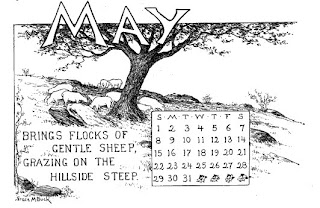
TOY MAKING FOR THE KINDERGARTEN
John Y. Dunlop, Greenfield, Tollcross, Glasgow. 1915
"The child's desire for constant and fresh amusement must be catered to in the classroom as well as in the home. Thus the teachers of very young children should always be on the look out for new material and new models for the most of children are keen on experimenting with unusual material and they often create new results from new material close at hand.
The first model in this series is a child's parachute which is made from a square of paper.
Make a hole in each corner as shown at Fig. 1.
Pass a piece of cotton through each hole, knot the end and see that the knot don't pass through.
Tie a large thread to the four collected ends of the string, and when flung up in the air, the parachute will open and descend slowly, or even float in the air.
This toy may be made in all colors which add very much to their bright appearance when floating in the air.
The construction of a balloon[hot air] is a more difficult model for young children. Procure an ordinary child's balloon, and cover this with an old hair net from home, or a loosely knitted light string bag.
See that the balloon is blown fully up. This part forms the gas bag. The balloon basket is made from a piece of square paper Fig. 4. Fold as shown, open out, fold up the sides, Fig. 5, then turn the corners round to make a complete open box.
Attach the basket to the gas bag with four pieces of cotton, Fig. 6.
Fig. 8 shows a pattern of a hanging basket. Fig. 7 gives the plan.
The paper which we use is usually six inches square.
Fold on the diagonals, cut on the solid line, Fig 7, and pass A part behind B part. Fix at the corners with wool.
Group the threads, knot and hang up.
Fig 10 and 11 shows a folded model of a flying bird. This handwork lesson is given with the spring lesson on happy birds.
Fold a piece of square paper into sixteen squares.
Open out, fold on the diagonal, open out.
From the windmill form fold into the vase, Fig. 11, fold backward and bring C down for the head along the dotted line.
Fig 10 shows the complete model."





















